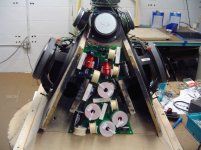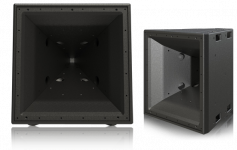A few ideas fron recent (1990's) history-
Sony made speakers with flat diaphragms of Hex sandwich material and I think four voice coil/motors on the back.
Another Japanese vendor ( forgot who) made speakers with an array of 4" drivers that had no surround. They had a felt "piston ring". Seemed to work OK.
Inverted domes are preferred for performance in a driver, but harder to make since it restricts space for the voice coil.
The shape of the cone actually has a lot of work behind it, including managing the speed of sound in the diaphragm vs in the surrounding air.
There is a woofer for Prosound that uses a motor to move a panel.
Sony made speakers with flat diaphragms of Hex sandwich material and I think four voice coil/motors on the back.
Another Japanese vendor ( forgot who) made speakers with an array of 4" drivers that had no surround. They had a felt "piston ring". Seemed to work OK.
Inverted domes are preferred for performance in a driver, but harder to make since it restricts space for the voice coil.
The shape of the cone actually has a lot of work behind it, including managing the speed of sound in the diaphragm vs in the surrounding air.
There is a woofer for Prosound that uses a motor to move a panel.
I thought bowl-shaped cones were not as good? My mid is a bowl cone, I actually discovered I could smooth out the response by putting a caterpillar-shaped hump of PVC tape on it, which acts like a phase plug. I can post before and after FFTs if anyone is interested.
My understanding from the trade is that the bowl shape is structurally better and not having the big transition from concave to convex at the dome should be a good thing. The phase issue is real but may also be affected by both the distance and the angle. The Manger driver I tested years ago seemed to have more output at high frequencies at right angles than straight on. That driver is a testament to the difference between surface wave and air wave. The Ohm is another example. Not an issue at 100 Hz but very much even at 1 KHz.
By running multiple concentric vc's, the entire plate moves as one. There are no surface acoustic waves ala ohm.
What disturbs me is concave. We are forcing a compressible medium using membrane that is not normal to the direction we are trying to move the media in. As we accelerate the air linearly on axis, it is also compressing radially because of the cone angle.
Ideally I would want the membrane to expand as a balloon would.
Jn
What disturbs me is concave. We are forcing a compressible medium using membrane that is not normal to the direction we are trying to move the media in. As we accelerate the air linearly on axis, it is also compressing radially because of the cone angle.
Ideally I would want the membrane to expand as a balloon would.
Jn
Ideally I would want the membrane to expand as a balloon would.
Jn
That's pretty close to a Quad 63. Or an MBL Football.
Even if the surface of the piston is perfect the pressure waves will interact when the dimensions of the radiator are larger than a wavelength. Similar problem with a microphone.
I was reading some of this and wondering if we weren't heading towards a better planar driver.
On which front (and going off at a tangent). Why are nearly all planar drivers singled ended? Only the eminence models have front and back magnets.
On which front (and going off at a tangent). Why are nearly all planar drivers singled ended? Only the eminence models have front and back magnets.
I thought bowl-shaped cones were not as good? My mid is a bowl cone, I actually discovered I could smooth out the response by putting a caterpillar-shaped hump of PVC tape on it, which acts like a phase plug. I can post before and after FFTs if anyone is interested.
Interesting, please show measurements.
The compressible media we work with certainly wants that.I was reading some of this and wondering if we weren't heading towards a better planar driver.
On which front (and going off at a tangent). Why are nearly all planar drivers singled ended? Only the eminence models have front and back magnets.
Has any vendor done an FEA considering the mass, compressibility, and heat capacity of the air in front of a driver during acceleration? The assumption that the air velocity vector is the same direction as the cone movement is flawed as the cone accelerates. It would be interesting to see at what point that concern is significant and where it can be ignored. Clearly DC is not impacted.
Jn
As I am a bear of very little brain I'm still trying to get my head around what the driver is trying to achieve before worrying about velocity vectors. For example , what if the Danley synergy concept was a potential optimal* way of doing things. If we accepted that, then we have a foundation onto which we can start looking at the problems with the implementation and how to make things better. For example, as Earl has pointed out, compression drivers create the wrong shaped wavefront so if we can make a flat wavefront there is an improvement. Then move to the next frequency band and see what the issues are.
*There are many solutions in this space and optimal may actual mean 'best that wife/room/budget can handle' But for now I'm meaning that it has the chance of moving reproduction forwards a few steps.
*There are many solutions in this space and optimal may actual mean 'best that wife/room/budget can handle' But for now I'm meaning that it has the chance of moving reproduction forwards a few steps.
Attachments
Did the digital actuator appear to be compitent? I haven't looked at them before. I just assume they would have a hard time.
I've seen fast and accurate enough devices, the problem is getting the amount of travel needed, still keeping cost low when built by automation. They didn't show me one that wasn't enclosed. We'll see!
It's supposed to be low cost to make in volume. Of course, in getting from research to reality a lot of dropouts occur....
True.
With this one after 10 years, they are at the wafer testing stage now
APPARATUS AND METHODS FOR GENERATING PRESSURE WAVES
George
True.
With this one after 10 years, they are at the wafer testing stage now
APPARATUS AND METHODS FOR GENERATING PRESSURE WAVES
George
I've been here before. Can someone who knows better look at their technology page? How can MEM's with microns of displacement generate any bass no matter how many you have?
http://www.audiopixels.com.au/index...nts-2018/digital-speaker-development-update1/
Last edited:
Talking about high speed scopes, this one, introduced in 1961, is nevertheless amazing 519 1 GHz Oscilloscope It appears the vert sensitivity and the rise time were calibrated for each unit. And how to clean these scopes from a nuclear blast debris.
Last edited:
I'm sure "modern" beryllium and carbon paste resistors would clean up that 60s scope nicely and it'd gain at least another GHz in usable bandwidth. 😉
(This is sarcasm in case anyone should be confused)
(This is sarcasm in case anyone should be confused)
Talking about high speed scopes, this one, introduced in 1961, is nevertheless amazing 519 1 GHz Oscilloscope It appears the vert sensitivity and the rise time were calibrated for each unit. And how to clean these scopes from a nuclear blast debris.
the 519 concept was invented by tech at LLNL. I knew him. He also produced a fiber optic 'crt' which was super fast response. It had no vert amp and took about a 1Kv pulse signal from nuclear detector. I think they were built for us by E.G.& G. IIRC. He ended up a EE group leader over at laser program.
-RM
Scopes were used during under ground nuclear tests in Nevada. I was on one of those 'events' using 519 and F.O. scopes. Trailers full of racks with scopes and cameras... later digitized by hand and then computer processed the data.
Last edited:
- Status
- Not open for further replies.
- Home
- Member Areas
- The Lounge
- John Curl's Blowtorch preamplifier part III

